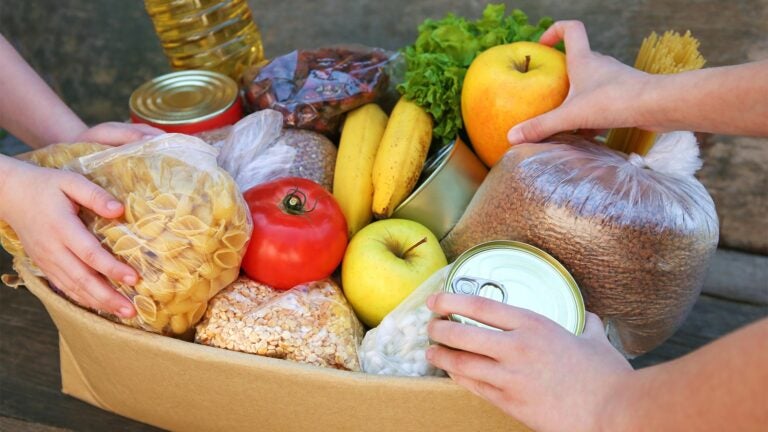
Researchers found adults who remained food insecure in the first half of 2021 are predominantly low-income, women, Latinos and between the ages of 18-40 years old. (Photo/iStock)
Food insecurity returns to pre-pandemic levels, but more than 1 in 10 Angelenos are still struggling
Nearly 1 million Los Angeles County residents are still food insecure, according to a new report spearheaded by USC Dornsife’s Public Exchange.
One in 3 Los Angeles County households experienced food insecurity — disruptions in eating because of a lack of money or resources — during April to December 2020. During the first half of 2021, the ratio fell to more than 1 in 10 Los Angeles County households, according to a new study directed by the Public Exchange at the USC Dornsife College of Letters, Arts and Sciences that analyzed the impact of COVID-19 on food insecurity.
“While it is encouraging to see food insecurity declining, it is still unacceptable that nearly 1 million Los Angeles County residents find it difficult to put food on the table,” said lead researcher Kayla de la Haye, an assistant professor of population and public health sciences at the Keck School of Medicine of USC.
“Fortunately, we have been able to identify initiatives that can address this challenge so that more of our fellow Angelenos no longer have to worry about feeding their families.”
Researchers found adults who remained food insecure in the first half of 2021 are predominantly low-income, women, Latinos and between the ages of 18-40 years old. Although CalFresh benefits helped transition households from being food insecure to food secure, just 1 in 4 food-insecure households were receiving CalFresh benefits — federally known as the Supplemental Nutrition Assistance Program, or SNAP — as of June 2021. More than a third of them live in “food deserts” — low-income areas with poor access to supermarkets and large grocery stores.
New data sources allowed new insights on food insecurity
The research included data provided by two private sector partners: Yelp, the company that connects people with local businesses; and findhelp.org, which provides a free search and referral platform tool to connect people seeking help with local free and reduced-cost programs. The partnerships allowed researchers to better understand resources and challenges for those experiencing food insecurity in real time.
“A lot of food outlets had to temporarily close or reduce their number of customers. An unintended consequence was that food access became more difficult, adding to the challenges of people with food insecurity,” de la Haye said.
“New sources of data allowed us to identify when and where these closures occurred, as well as neighborhoods with a double burden of food deserts and ‘food assistance deserts,’ meaning no food assistance providers were nearby.”
Understanding a changed food environment in Los Angeles
The data from Yelp and findhelp.org deepened researchers’ understanding of food insecurity, leading to the following insights:
- One in 3 census tracts in the Antelope Valley and South L.A. face the double burden of being food deserts and food assistance deserts.
- More than three-quarters (77%) of census tracts that are food deserts have no food assistance providers.
- One in 3 people experiencing food insecurity had difficulty getting food because they lacked transportation or because food stores were either closed or had limited hours.
- Half of the people who were food insecure couldn’t get groceries delivered.
- The spike in the number of food outlets throughout the county that closed, at least temporarily, was particularly high among fast-food and full-service restaurants.
“Identifying how barriers to food security change during a crisis is particularly important to ensure emergency mitigation measures are addressing the right populations in time,” de la Haye said.
“Collaborating with private-sector organizations, such as Yelp and findhelp.org, revolutionizes our ability to analyze time-sensitive information quickly so our research can inform solutions.”
‘Translational science’ brings research findings to real-world solutions
The report on the findings includes several recommendations for L.A. County:
- Targeted outreach to enroll more food-insecure people in CalFresh.
- Investigate community perspectives by interviewing those impacted by food insecurity.
- Address equitable access to food through urban planning.
- Monitor and invest in fair and resilient food systems by building partnerships with researchers, government, community organizations and private partners before a crisis hits.
USC Dornsife’s Public Exchange study was conducted in collaboration with the L.A. County Emergency Food Security Branch. USC researchers regularly met with county partners throughout the pandemic to share the latest findings on changes to food insecurity. L.A. County officials plan to launch a new Food Equity Roundtable this month to continue increasing the resilience of the food system and food access across the county.
The roundtable is co-led by L.A. County and its philanthropic partners: Annenberg Foundation, California Community Foundation and Weingart Foundation. It is a coalition of leading cross-sector organizations dedicated to advancing food justice and addressing inequities in food systems for the most vulnerable in the region.”
“These research findings demonstrate the need for us to continue with our efforts towards building equitable and sustainable food support systems. We will build upon the cross-sector collaboration with government, philanthropy, community-based organizations, academia and others to provide food assistance during this pandemic, as well as better prepare for other challenging times,” said Swati Chandra, director of the L.A. County Food Equity Roundtable.
The USC Dornsife Public Exchange/L.A. County partnership will continue to explore causes of and potential solutions to food insecurity through new funding from the National Science Foundation.
Data partners react to Los Angeles food insecurity study
“Yelp’s mission to connect people with great local businesses aligns with the ethos of USC’s research into food insecurity in L.A. County,” said Justin Norman, vice president of data science at Yelp. “We are proud to partner with USC and L.A. County to leverage Yelp’s extensive dataset on the local food environment in a way that underscores the need for more connection between food sources and those in the community who need them most.”
“Findhelp.org has spent over a decade building the most comprehensive network of social services in the nation to help connect people to local community programs with dignity and ease. Sharing this data with researchers enhances our collective understanding of existing gaps in services and improves our ability to help those who are most vulnerable,” said Bella Kirchner, research director at findhelp.org.
USC Dornsife’s Public Exchange spearheaded the study, which was conducted by researchers from the Keck School of Medicine of USC, the USC Dornsife Spatial Sciences Institute and the USC Price School of Public Policy, with collaboration from the Los Angeles County Emergency Food Security Branch. It was supported by the USC Dornsife Emergency Fund and by the Keck School of Medicine of USC COVID-19 Research Fund through a generous gift from the W. M. Keck Foundation.
The findings are from data supplied by the Understanding Coronavirus in America tracking survey administered by the USC Dornsife Center for Economic and Social Research (CESR). The approximately 1,800 survey respondents are L.A. County adults who are members of CESR’s Understanding America Study probability-based internet panel. They participated in the tracking survey between April 2020 and June 2021.
Based at the USC Dornsife College of Letters, Arts and Sciences, Public Exchange fast-tracks collaborations between academic researchers and the public and private sectors to define, analyze and solve complex problems together.



